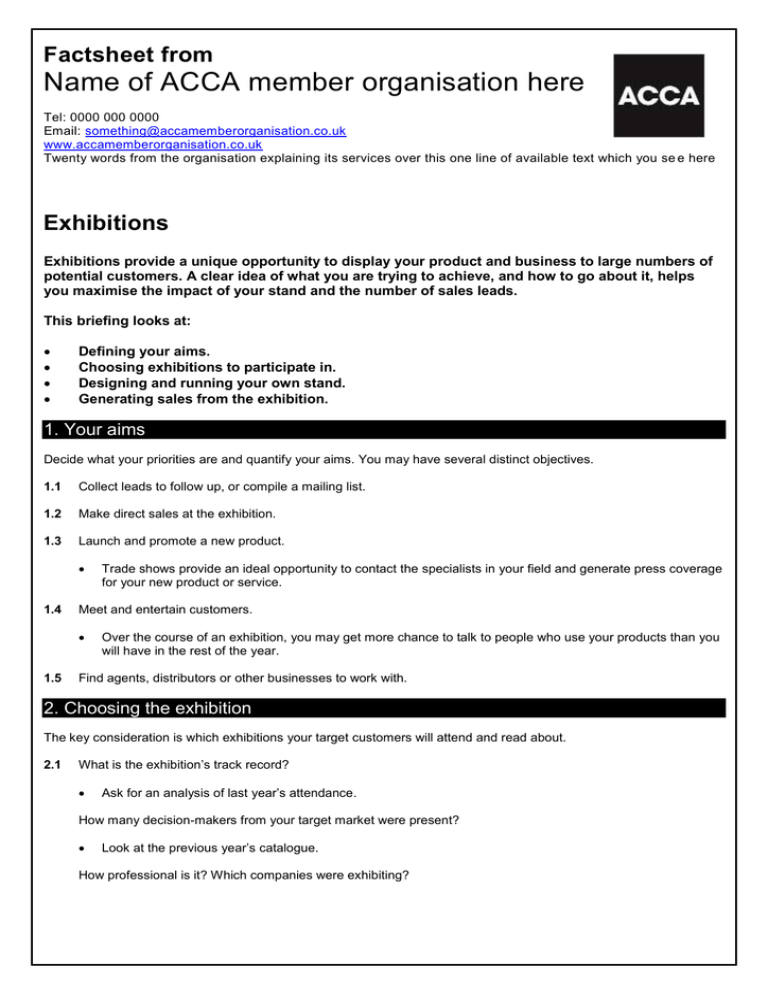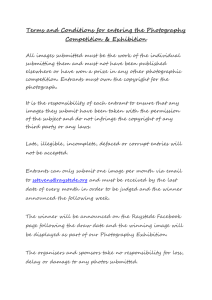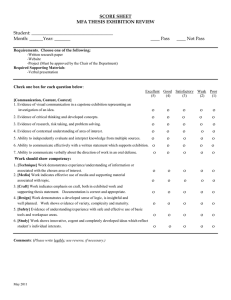
Factsheet from
Name of ACCA member organisation here
Tel: 0000 000 0000
Email: something@accamemberorganisation.co.uk
www.accamemberorganisation.co.uk
Twenty words from the organisation explaining its services over this one line of available text which you se e here
Exhibitions
Exhibitions provide a unique opportunity to display your product and business to large numbers of
potential customers. A clear idea of what you are trying to achieve, and how to go about it, helps
you maximise the impact of your stand and the number of sales leads.
This briefing looks at:
Defining your aims.
Choosing exhibitions to participate in.
Designing and running your own stand.
Generating sales from the exhibition.
1. Your aims
Decide what your priorities are and quantify your aims. You may have several distinct objectives.
1.1
Collect leads to follow up, or compile a mailing list.
1.2
Make direct sales at the exhibition.
1.3
Launch and promote a new product.
1.4
Meet and entertain customers.
1.5
Trade shows provide an ideal opportunity to contact the specialists in your field and generate press coverage
for your new product or service.
Over the course of an exhibition, you may get more chance to talk to people who use your products than you
will have in the rest of the year.
Find agents, distributors or other businesses to work with.
2. Choosing the exhibition
The key consideration is which exhibitions your target customers will attend and read about.
2.1
What is the exhibition’s track record?
Ask for an analysis of last year’s attendance.
How many decision-makers from your target market were present?
Look at the previous year’s catalogue.
How professional is it? Which companies were exhibiting?
2.2
Ask your competitors what they got from attending — most people will tell you.
Ask your customers, if they attend, why and how useful the event is.
Be wary of first-year shows. Consider attending as a customer first and then exhibiting the following year.
When is the exhibition?
Is that a good time for your business to be disrupted by the extra work?
Could you cope with the extra business the exhibition generates?
2.3
Where is the exhibition?
2.4
Smaller and more specialised exhibitions may represent better value for money.
How much publicity does the exhibition receive?
2.6
Is the location convenient for you and your target customers?
What size is the exhibition?
2.5
How far in advance will you need to plan?
How and where will the organisers advertise the event?
Do they have any links to the media?
What else will the exhibition offer?
What services will the organisers provide?
What special events will there be?
Attend any networking events to maximise your ROI.
2.7
Will your trade association have a stand for members there?
How much does it cost?
Exhibition organisers charge rent on the floor space.
3. Booking space
3.1
Make sure you book a space suitable for your proposed display (see 4).
Ask for a map of the hall.
Ask the organisers which parts of the exhibition have attracted the most attention in the past.
Stands with more frontage are likely to attract more attention.
Try to get near a main aisle and think about footfall.
You can see how the crowd moves by attending an exhibition at that venue.
3.2
Book early to ensure that your name is included in all the organisers’ promotional materials (see 5).
3.3
Sometimes a café or feature is a good place to have a stand.
The organisers usually require a deposit when you book and full payment before the exhibition starts.
Arrange electricity, lighting and any other supplies you require. For example, internet access.
Many organisers require you to use their own contractors to install these.
Plan your electrical requirements carefully — an average socket can cost in excess of £100.
2
4. Stand design
4.1
Exhibition organisers usually offer a ‘shell scheme’.
This normally includes the back and side walls of your stand, a fascia, carpet, nameboard and a 500w electrical socket.
Extras which may be included are:
4.2
electrical supplies and lighting
online access
furniture
shelving
You can use your own designer or a design agency.
A designer is more likely to produce a distinctive stand.
A designer is essential for a space-only site.
Use a reputable company that knows what the organisers’ rules are.
In particular, you will be responsible for health and safety, and any fire risk your stand may represent.
Brief the designer on what you hope to achieve.
If you plan to exhibit regularly, a modular stand that can be taken apart and re-used may be best.
4.3
Confirm the time and costs schedule in writing.
Make sure your stand design is effective.
You will have only a few seconds to attract the attention of people passing the stand.
Make sure your stand is well lit.
Use multimedia such as laptops or tv.
Have one central theme rather than trying to crowd everything onto the stand.
Keep it simple.
Allow space for visitors.
Keep the front clear and provide a focal point at the back to encourage them into the stand.
Avoid building a ‘corporate fortress’ to mark your territory.
5. Exhibition promotion
5.1
Let target customers know about your stand.
Ask the organisers for free complimentary tickets to send to selected customers.
A press release is a must.
Briefly describe your stand and your product. Include pictures and samples if appropriate. Give details of how
they can contact you for further information.
5.2
Use advertisements (online and off) or direct mail to announce your presence at the exhibition.
Make the most of the organisers’ PR and promotional materials.
3
Ensure that your name appears in the catalogue — this is normally free.
You should be offered a free listing, and you may want to advertise as well.
Ask the organisers what their PR plans are and whether they will have a press office you can use for your
own PR.
Tell them if something about you is particularly newsworthy.
Offer to take part in special events to gain extra exposure, eg give a speech.
If you are planning to attend an overseas or international exhibition, see 9.2.
6. Running the stand
6.1
Plan the details well in advance.
When will you set up the stand?
Where will your packing materials be stored?
When will electricity supplies, lighting and any special requirements be installed?
Have you got an adequate supply of brochures, leaflets, business cards and product samples? Where will
you keep them?
How will the stand be kept clean and tidy?
What are the security arrangements?
Does your office insurance cover the exhibition?
6.2
Will there be refreshments for your team and visitors?
Plan your message.
How will you respond to different types of visitors?
What information will you give out to visitors who are unlikely to be customers in the near future?
What will you say to journalists or VIPs who visit the stand? Who will look after them?
How will you handle competitors who are looking for information?
Prepare briefing notes for all employees.
6.3
The right employees are essential to create a good impression.
Always appoint a stand manager.
Make this person responsible for timetabling and for briefing everybody involved.
Choose personable and knowledgeable employees.
Ideally, your stand should always have one sales expert and one technical expert.
Allow for breaks.
If the same people are on the stand all day, they will become tired and jaded.
6.4
Employees should be smart and punctual.
A good selling technique is vital (see 7).
Attract attention to the stand.
4
Activities like displays and demonstrations will help generate interest in your stand.
Activities visitors can participate in are likely to be more effective.
Prize draws can be a good way of collecting names and addresses of potential customers.
Refreshments perk up tired visitors and encourage them to spend more time on your stand.
7. Selling technique
Most exhibitors aim to make introductory contacts rather than to complete sales on the spot.
7.1
Respond to visitors.
A visitor should be allowed to browse briefly and then be approached.
Employees must not hide at the back of the stand chatting among themselves.
7.2
Start by finding out what kind of visitors you have.
Ask whether they use your kind of product and what their interest is in your stand.
Ask what their roles are in their organisations and what their businesses do.
Don’t ask ‘closed questions’ such as, “Can I help you?” The answer will often be no.
Find out whether a visitor has purchasing power or influence.
7.3
Stress the benefits of your product.
If a visitor is a potential customer, you must create enough interest to pave the way for a follow -up meeting or call.
7.4
Find out what the visitor’s needs are.
Explain how your product can satisfy those needs.
Make arrangements to follow up.
A visitor should not leave your stand until you have agreed what the next step will be.
Make sure you record the name, job title and area of interest of each prospective customer.
Record any information you need for following up the enquiry. Who should you contact, when and how?
Rate your leads to ensure you follow up the best first.
Arrange to get one of the organisers’ mailing lists and consider mailing everybody who attended, even if they
did not come to your stand.
Your aim is to deal with as many visitors as possible. Five minutes should be long enough to interest the visitor,
provide them with relevant information and make follow-up arrangements.
8. Cost
8.1
Floor space rental costs typically start at a £200 a square metre.
8.2
Services (electrical outlets, furniture, plants) can add up to 20 per cent extra to the cost.
Costs will generally be higher for exhibitions with high attendances and for some specialist exhibitions.
Total costs will include several other elements, such as:
stand design, delivery and installation
furniture hire
the cost of three employees for the duration of the exhibition in order to have two employees on the stand at
all times
5
8.3
publicity costs of any direct mail, advertising or PR
miscellaneous costs (eg insurance)
Calculate how cost-effective an exhibition is likely to be in achieving your aims.
If you aim to get leads (and sales), what is the expected cost per lead, and how does that compare with the
anticipated profits you will ultimately make?
If you want to get exposure, how much coverage do you expect?
How much coverage could you get by spending the same amount on an alternative promotional effort?
Be realistic about how many visitors you will be able to see, and what percentage will produce a positive result.
8.4
Measure the results of the exhibition once it is over. Did you achieve your aims?
How much press coverage did you get?
How many leads did you generate?
How many sales resulted from them?
What was the total cost?
How does this compare with the cost-effectiveness of alternatives, such as direct mail?
9. Getting help
9.1
You can get information about upcoming exhibitions from a variety of sources.
9.2
Ask your local trade association.
Contact the Association of Event Organisers (01442 285 810 or visit www.aeo.org.uk).
Event Magazine is published 12 times a year, and is available by subscription (020 8267 5000 or visit
www.eventmagazine.co.uk).
The Exhibition Bulletin is published 12 times a year, and is available by subscription (020 8971 8282 or visit
www.mashmedia.co.uk).
You may be able to get government assistance if you plan to attend an overseas or international exhibition.
Contact UK Trade & Investment for details of relevant schemes (020 7215 8000 or www.ukti.gov.uk).
Expert contributors
Thanks to Neil Gotting (Dalesgate Exhibitions, 01423 502 031); Simon Naudi (Answers Training International Ltd,
01252 845 500).
Last updated 01.06.11
© BHP Information Solutions 2011. ISSN 1369-1996. All rights reserved. No part of this publication may be reproduced or transmitted without the
written permission of the publisher. This publication is for general guidance only. The publisher, expert contributors and distributor disclaim all liability
for any errors or omissions. Consult your local business support organisation or your professional adviser for help and advice.
6



